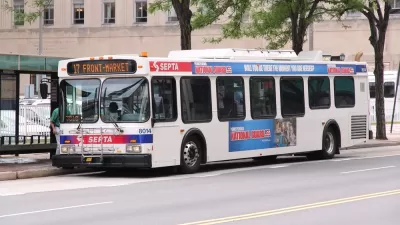The author of ‘The Great American Transit Disaster’ explains how U.S. transit agencies got to the existential crisis they face today.

In an interview in Bloomberg CityLab, David Zipper speaks with author Nicholas Dagen Bloom about his new book, The Great American Transit Disaster, in which Dagen Bloom describes how “US public transportation has lurched from one crisis to the next throughout the past century.”
Zipper writes, “Focusing on the histories of Atlanta, Baltimore, Boston, Chicago, Detroit and San Francisco, Bloom rejects the idea that there was anything preordained about the descent of private transit operators into bankruptcy or the decline in service offered by the public agencies that have operated buses and trains ever since.”
As Zipper notes, “It’s mind-blowing to consider just how good transit service once was.” In the early 20th century, transit was, Dagen Bloom adds, “a very profitable business,” but not for the reasons we might think. “The big money was always in the land development. Once the transit lines were built, the land was basically developed around them.”
While the rise of automobiles did have an impact on transit ridership, Dagen Bloom believes that “there was a whole series of compounding decisions made by city leaders, state leaders and private sector people” that led to the decline of transit systems. “You didn’t have to build systems of parkways and highways that were so comprehensive that you sacrifice neighborhoods. You didn’t have to completely demolish your downtowns, create massive federal programs that paid for parking ramps and give tax breaks on downtown parking.”
Ultimately, Dagen Bloom concludes, to save American transit, “someone’s got to fund transit” to pull agencies out of their current death spiral.
FULL STORY: Anatomy of an ‘American Transit Disaster’

Alabama: Trump Terminates Settlements for Black Communities Harmed By Raw Sewage
Trump deemed the landmark civil rights agreement “illegal DEI and environmental justice policy.”

Planetizen Federal Action Tracker
A weekly monitor of how Trump’s orders and actions are impacting planners and planning in America.

The 120 Year Old Tiny Home Villages That Sheltered San Francisco’s Earthquake Refugees
More than a century ago, San Francisco mobilized to house thousands of residents displaced by the 1906 earthquake. Could their strategy offer a model for the present?

In Both Crashes and Crime, Public Transportation is Far Safer than Driving
Contrary to popular assumptions, public transportation has far lower crash and crime rates than automobile travel. For safer communities, improve and encourage transit travel.

Report: Zoning Reforms Should Complement Nashville’s Ambitious Transit Plan
Without reform, restrictive zoning codes will limit the impact of the city’s planned transit expansion and could exclude some of the residents who depend on transit the most.

Judge Orders Release of Frozen IRA, IIJA Funding
The decision is a victory for environmental groups who charged that freezing funds for critical infrastructure and disaster response programs caused “real and irreparable harm” to communities.
Urban Design for Planners 1: Software Tools
This six-course series explores essential urban design concepts using open source software and equips planners with the tools they need to participate fully in the urban design process.
Planning for Universal Design
Learn the tools for implementing Universal Design in planning regulations.
Clanton & Associates, Inc.
Jessamine County Fiscal Court
Institute for Housing and Urban Development Studies (IHS)
City of Grandview
Harvard GSD Executive Education
Toledo-Lucas County Plan Commissions
Salt Lake City
NYU Wagner Graduate School of Public Service





























